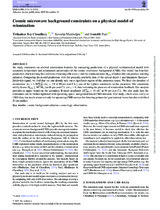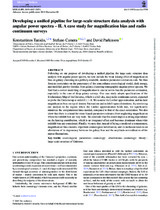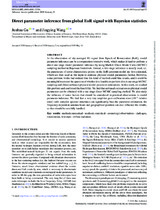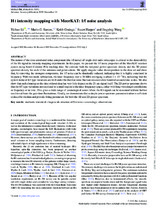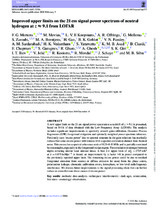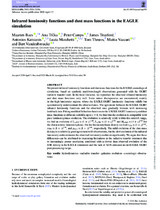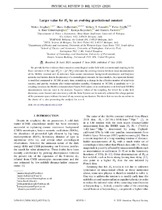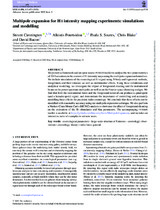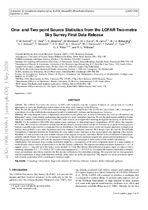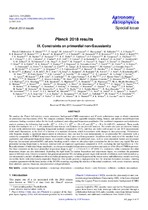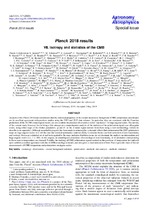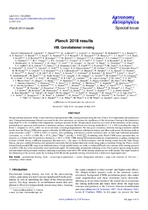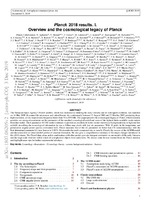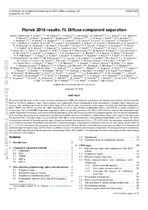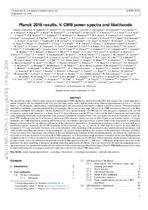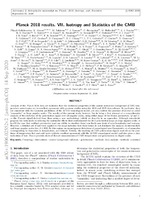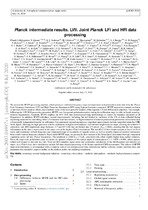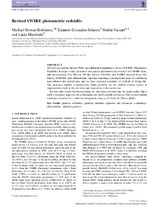Browsing by Subject "Cosmology: observations"
Now showing items 1-18 of 18
-
Cosmic microwave background constraints on a physical model of reionization
(Oxford University Press, 2021)We study constraints on allowed reionization histories by comparing predictions of a physical seminumerical model with secondary temperature and polarization anisotropies of the cosmic microwave background (CMB). Our model ... -
Developing a unified pipeline for large-scale structure data analysis with angular power spectra – II. A case study for magnification bias and radio continuum surveys
(Oxford University Press, 2019)Following on our purpose of developing a unified pipeline for large-scale structure data analysis with angular power spectra, we now include the weak lensing effect of magnification bias on galaxy clustering in a publicly ... -
Direct parameter inference from global EoR signal with Bayesian statistics
(Oxford University Press, 2020)In the observation of sky-averaged HI signal from Epoch of Reionization (EoR), model parameter inference can be a computation-intensive work, which makes it hard to perform a direct one-stage model parameter inference by ... -
H i intensity mapping with MeerKAT: 1/f noise analysis
(Oxford University Press, 2021)The nature of the time correlated noise component (the 1/f noise) of single dish radio telescopes is critical to the detectability of the H i signal in intensity mapping experiments. In this paper, we present the 1/f noise ... -
Improved upper limits on the 21 cm signal power spectrum of neutral hydrogen at z ≈ 9.1 from LOFAR
(Oxford University Press, 2020)A new upper limit on the 21 cm signal power spectrum at a redshift of z ≈ 9.1 is presented, based on 141 h of data obtained with the Low-Frequency Array (LOFAR). The analysis includes significant improvements in spectrally ... -
Infrared luminosity functions and dust mass functions in the EAGLE simulation
(Oxford University Press, 2020)We present infrared luminosity functions and dust mass functions for the EAGLE cosmological simulation, based on synthetic multiwavelength observations generated with the SKIRT radiative transfer code. In the local Universe, ... -
Larger value for H0 by an evolving gravitational constant
(American Physical Society, 2020)We provide further evidence that a massless cosmological scalar field with a nonminimal coupling to the Ricci curvature of the type M 2 pl ( 1 + ξ σ n / M n pl ) alleviates the existing tension between ... -
Multipole expansion for H I intensity mapping experiments: simulations and modelling
(Oxford University Press, 2020)We present a framework and an open-source PYTHON toolkit to analyse the two-point statistics of 3D fluctuations in the context of H I intensity maps using the multipole expansion formalism. We include simulations of the ... -
One- and Two-point source statistics from the LOFAR Two-metre sky survey first data release
(ESO, 2020)Context. The LOFAR Two-metre Sky Survey (LoTSS) will eventually map the complete Northern sky and provide an excellent opportunity to study the distribution and evolution of the large-scale structure of the Universe. Aims. ... -
Planck 2018 results IX. Constraints on primordial non-Gaussianity
(EDP Sciences, 2020)We analyse the Planck full-mission cosmic microwave background (CMB) temperature and E-mode polarization maps to obtain constraints on primordial non-Gaussianity (NG). We compare estimates obtained from separable ... -
Planck 2018 results VII. Isotropy and statistics of the CMB
(EDP Sciences, 2020)Analysis of the Planck 2018 data set indicates that the statistical properties of the cosmic microwave background (CMB) temperature anisotropies are in excellent agreement with previous studies using the 2013 and 2015 data ... -
Planck 2018 results VIII. Gravitational lensing
(EDP Sciences, 2020)We present measurements of the cosmic microwave background (CMB) lensing potential using the final Planck 2018 temperature and polarization data. Using polarization maps filtered to account for the noise anisotropy, we ... -
Planck 2018 results: I. Overview and the cosmological legacy of Planck
(EDP Sciences, 2020)The European Space Agency’s Planck satellite, which was dedicated to studying the early Universe and its subsequent evolution, was launched on 14 May 2009. It scanned the microwave and submillimetre sky continuously between ... -
Planck 2018 results: IV. Diffuse component separation
(EDP Sciences, 2020)We present full-sky maps of the cosmic microwave background (CMB) and polarized synchrotron and thermal dust emission, derived from the third set of Planck frequency maps. These products have significantly lower contamination ... -
Planck 2018 results: V. CMB power spectra and likelihoods
(EDP Sciences, 2020)We describe the legacy Planck cosmic microwave background (CMB) likelihoods derived from the 2018 data release. The overall approach is similar in spirit to the one retained for the 2013 and 2015 data release, with a hybrid ... -
Planck 2018 results: VII. Isotropy and statistics of the CMB
(EDP Sciences, 2020)Analysis of the Planck 2018 data set indicates that the statistical properties of the cosmic microwave background (CMB) temperature anisotropies are in excellent agreement with previous studies using the 2013 and 2015 data ... -
Planck intermediate results. LVII. Joint Planck LFI and HFI data processing
(ESO, 2020)We present the NPIPE processing pipeline, which produces calibrated frequency maps in temperature and polarization from data from the Planck Low Frequency Instrument (LFI) and High Frequency Instrument (HFI) using ... -
Revised SWIRE photometric redshifts
(Oxford University Press, 2013)We have revised the Spitzer Wide-Area Infrared Extragalactic survey (SWIRE) Photometric Redshift Catalogue to take account of new optical photometry in several of the SWIRE areas, and incorporating Two Micron All Sky ...

